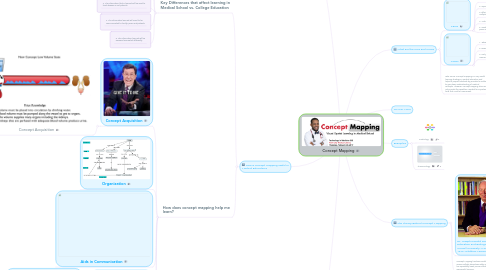
1. What is concept mapping?
1.1. Concept mapping is a graphical representation of the connections and derivation knowledge and information.
1.2. There are many types of concept map formats: Spider, Flow-Chart (Timelines, Fish Chart, Spiral & Circular), Hierarchy (Top-Down, Bottom Up), and Systems
1.3. The maps all have the same components: Nodes and Lines. 1. Nodes - works name of topic/idea/concept 2. Lines - to show connectivity (links) between concepts mainly and can be used to convey information themselves.
2. How is concept mapping useful in Medical Education?
2.1. Key Differences that affect learning in Medical School vs. College Education
2.1.1. 1. Increased volume of information.
2.1.2. 2. Information needed is more focused on health related topics.
2.1.3. 3. The information that is learned will be used to treat disease in real patients.
2.1.4. 4. The information learned will need to be communicated to faculty, peers and patients.
2.1.5. 5. The information learned will be assessed somewhat differently.
2.2. How does concept mapping help me learn?
2.2.1. Concept Acquisition
2.2.1.1. Concept Acquisition
2.2.1.1.1. Applying this to Mapping
2.2.2. Organization
2.2.3. Aids in Communication
2.2.4. Integration
2.2.4.1. Integration
2.2.5. Spark Curiousity
2.2.5.1. Familial NEHI
3. Objectives
3.1. 1. Learn the components of a concept map
3.2. 2. Understand the usefulness of concept mapping as a learning tool.
3.3. 3. Learn how to apply concept mapping as learning strategy in medical education.
3.4. 4. Evaluate some of the Pros and Cons to using concept mapping in medical education.
4. What are the Pros and Cons?
4.1. PROs
4.1.1. 1. Great for long-term memory
4.1.2. 2. Improves understanding of concepts.
4.1.3. 3. Effective for integrating information from multiple classes.
4.1.4. 4. Aids in communication of complex concepts.
4.1.5. 5. Great teaching tool for medical students, peers and patients.
4.2. CONs
4.2.1. 1. Takes time to make maps (at first).
4.2.2. 2. Does not provide the repetition of concepts.
4.2.3. 3. Not good for topics that require rote memorization or rote learning.
4.3. Take Home: Concept mapping is a very useful learning strategy in medical education and helps to prepare students by provided a method to gain deep understanding of medical concepts. However, concept mapping alone will not provide the repetition needed for important facts that must be memorized.
4.3.1. Resolve: Divide learning materials into information that must use rote learning from concepts that must be learned meaningfully. *We are taking care of REAL Patients!
5. THANK YOU!
6. Examples
6.1. Cardiology
6.2. Pharmacology
7. The Theory Behind Concept Mapping
7.1. Dr. Joseph Donald Novak, professor of Education and Biological Sciences at Cornell University * Human Cognition, 1972 *Children Learning Science
7.1.1. Dr. David Ausubel theory of cognitive psychology. Meaningful learning takes place when a new concept is rooted or surrounded by known concepts. Around age 3 children begin to develop the ability to understand concepts, heavily based on language and repetition. Note: Rote memorization still has a role.
7.1.1.1. 1. Concepts must be clearly defined.
7.1.1.2. 2. Concepts must related to what is already known by the learner.
7.1.1.3. 3. Meaningful learning is up to the learner but can be indirectly influenced by proper instruction and evaluation.
7.2. Concept Mapping has been widely studied across multiple disciplines within Education and has repeatedly been proven effective in meaningful learning.
7.2.1. Concept mapping has been shown to improve organization of knowledge, integration of concepts, concept acquisition, improved communication of learned knowledge, increased awareness of gaps in knowledge.
7.2.1.1. Data on test preparedness varied depending on the study.
